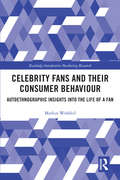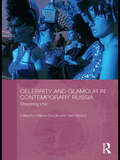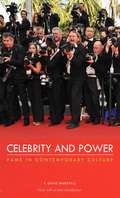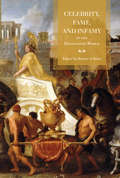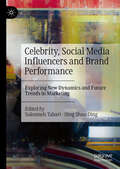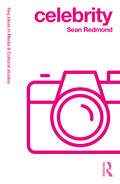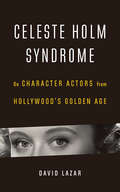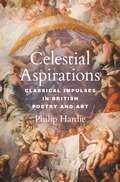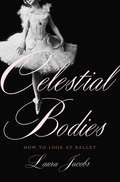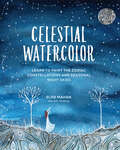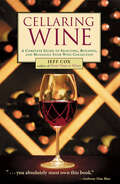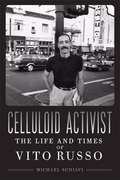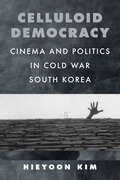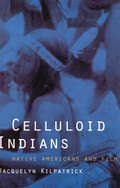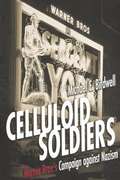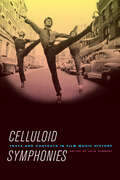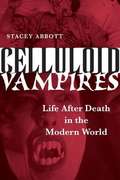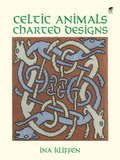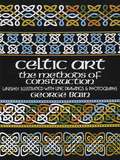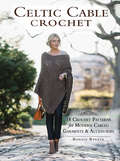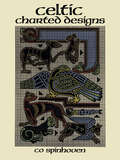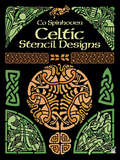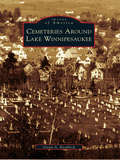- Table View
- List View
Celebrity Fans and Their Consumer Behaviour: Autoethnographic Insights into the Life of a Fan (Routledge Interpretive Marketing Research)
by Markus WohlfeilEver since the dawn of the Hollywood star system in the early 1920s, consumers have been fascinated by film stars and other celebrities and their seemingly glamorous private lives. The public demand for celebrities has become so pervasive that it is arguably an essential element of our everyday culture and market economy, and the focus of increasing study. This book explores the widespread phenomenon of celebrity fandom and provides a deeper understanding of why individual consumers develop an emotional attachment to their favourite celebrity and what this parasocial fan relationship means in their life. Based on an in-depth insider study of a consumer’s fan relationship with a film actress, the book provides unique insights into the celebrity-fan relationship, revealing the meaning it has for the consumer in everyday life, and how it evolves and expresses itself over time. While this book is primarily located within the field of consumer research, fandom and celebrity are of interest to a variety of academic disciplines. It will appeal to an interdisciplinary audience from marketing and consumer research, film studies, media studies, cultural studies, and sociology.
Celebrity and Glamour in Contemporary Russia: Shocking Chic (BASEES/Routledge Series on Russian and East European Studies)
by Helena GosciloThis is the first book to explore the phenomenon of glamour and celebrity in contemporary Russian culture, ranging across media forms, disciplinary boundaries and modes of inquiry, with particular emphasis on the media personality. The book demonstrates how the process of ‘celebrification’ in Russia coincides with the dizzying pace of social change and economic transformation, the latter enabling an unprecedented fascination with glamour and its requisite extravagance; how in the 1990s and 2000s, celebrities - such as film or television stars - moved away from their home medium to become celebrities straddling various media; and how celebrity is a symbol manipulated by the dominant culture and embraced by the masses. It examines the primacy of the visual in celebrity construction and its dominance over the verbal, alongside the interdisciplinary, cross-media, post-Soviet landscape of today’s fame culture. Taking into account both general tendencies and individual celebrities, including pop-diva Alla Pugacheva and ex-President and current Prime Minister Vladimir Putin, the book analyses the internal dynamics of the institutions involved in the production, marketing, and maintenance of celebrities, as well as the larger cultural context and the imperatives that drive Russian society’s romance with glamour and celebrity.
Celebrity and Power: Fame in Contemporary Culture
by P. David MarshallSimultaneously celebrated and denigrated, celebrities represent not only the embodiment of success, but also the ultimate construction of false value. Celebrity and Power questions the impulse to become embroiled with the construction and collapse of the famous, exploring the concept of the new public intimacy: a product of social media in which celebrities from Lady Gaga to Barack Obama are expected to continuously campaign for audiences in new ways. In a new Introduction for this edition, P. David Marshall investigates the viewing public&’s desire to associate with celebrity and addresses the explosion of instant access to celebrity culture, bringing famous people and their admirers closer than ever before.
Celebrity, Fame, and Infamy in the Hellenistic World (Phoenix Supplementary Volumes)
Modern notions of celebrity, fame, and infamy reach back to the time of Homer's Iliad. During the Hellenistic period, in particular, the Greek understanding of fame became more widely known, and adapted, to accommodate or respond to non-Greek understandings of reputation in society and culture. This collection of essays illustrates the ways in which the characteristics of fame and infamy in the Hellenistic era distinguished themselves and how they were represented in diverse and unique ways throughout the Mediterranean. The means of recording fame and infamy included public art, literature, sculpture, coinage, and inscribed monuments. The ruling elite carefully employed these means throughout the different Hellenistic kingdoms, and these essays demonstrate how they operated in the creation of social, political, and cultural values. The authors examine the cultural means whereby fame and infamy entered social consciousness, and explore the nature and effect of this important and enduring sociological phenomenon.
Celebrity, Performance, Reception
by David WorrallBy 1800 London had as many theatre seats for sale as the city's population. This was the start of the capital's rise as a centre for performing arts. Bringing to life a period of extraordinary theatrical vitality, David Worrall re-examines the beginnings of celebrity culture amidst a monopolistic commercial theatrical marketplace. The book presents an innovative transposition of social assemblage theory into performance history. It argues that the cultural meaning of drama changes with every change in the performance location. This theoretical model is applied to a wide range of archival materials including censor's manuscripts, theatre ledger books, performance schedules, unfamiliar play texts and rare printed sources. By examining prompters' records, box office receipts and benefit night takings, the study questions the status of David Garrick, Sarah Siddons and Edmund Kean, and recovers the neglected actress, Elizabeth Younge, and her importance to Edmund Burke.
Celebrity, Social Media Influencers and Brand Performance: Exploring New Dynamics and Future Trends in Marketing
by Saloomeh Tabari Qing Shan DingCelebrity endorsement has shown to be an effective way enhancing brand-related attitudes, reinforcing behavioural intentions, and shaping brand perceptions. Indeed, companies devote a lot of resources on celebrity endorsement to exploit emotional bonds between consumers and brands in order to accomplish their desired brand image and increase brand awareness, differentiation, and brand loyalty. In short, brands that are endorsed by a favourite celebrity and influencer become more credible and trustworthy. This edited book examines this new era of marketing by focusing on the impact of employing celebrities, SMIs and virtual influencers to endorse the brand as a key advertising tactic. In particular, it focuses on the rise of social media usage and the corresponding changes in advertising strategies in the digital era. As well as exploring this rise of celebrity influencers and their value, the book also takes a critical lens, examining their roles in fuelling the growth of materialism, causing mental health issues among adolescents, and aiding the development of fast fashion. With this balanced and comprehensive approach, this book is an essential resource for anyone interested in the future of advertising.
Celebrity: New Directions In Celebrity Culture (Key Ideas in Media & Cultural Studies)
by Sean RedmondCelebrity introduces the key terms and concepts, dilemmas and issues that are central to the study and critical understanding of celebrity. Drawing on two dynamic models from two different modes of enquiry – the circuit of celebrity culture and the circuit of celebrity affect – this book explores the multi-layered, multi-faceted contexts and concepts that sit within and surround the study of celebrity. Through building a critical story about celebrity, Sean Redmond discusses key topics such as identity and representation; the celebrity body; the consumption of celebrity and celebrity culture; and the sensory connection between fans and celebrities, gender, activism, gossip and toxicity. Including case studies on Miley Cyrus, David Bowie, Scarlett Johansson and Kate Winslet, Celebrity is a dynamic and topical volume ideal for students and academics in celebrity and cultural studies.
Celeste Holm Syndrome: On Character Actors from Hollywood's Golden Age
by David LazarIn this essay collection David Lazar looks to our intimate relationships with characters, both well-known and lesser known, from Hollywood&’s Golden Age. Veering through considerations of melancholy and wit, sexuality and gender, and the surrealism of comedies of the self in an uncanny world, mixed with his own autobiographical reflections of cinephilia, Lazar creates an alluring hybrid of essay forms as he moves through the movies in his mind. Character actors from the classical era of the 1930s through the 1950s including Thelma Ritter, Oscar Levant, Martin Balsam, Nina Foch, Elizabeth Wilson, Eric Blore, Edward Everett Horton, and the eponymous Celeste Holm all make appearances in these considerations of how essential character actors were, and remain, to cinema.
Celestial Aspirations: Classical Impulses in British Poetry and Art (E. H. Gombrich Lecture Series #6)
by Philip HardieA unique look at how classical notions of ascent and flight preoccupied early modern British writers and artistsBetween the late sixteenth century and early nineteenth century, the British imagination—poetic, political, intellectual, spiritual and religious—displayed a pronounced fascination with images of ascent and flight to the heavens. Celestial Aspirations explores how British literature and art during that period exploited classical representations of these soaring themes—through philosophical, scientific and poetic flights of the mind; the ascension of the disembodied soul; and the celestial glorification of the ruler.From textual reachings for the heavens in Spenser, Marlowe, Shakespeare, Donne and Cowley, to the ceiling paintings of Rubens, Verrio and Thornhill, Philip Hardie focuses on the ways that the history, ideologies and aesthetics of the postclassical world received and transformed the ideas of antiquity. In England, narratives of ascent appear on the grandest scale in Milton’s Paradise Lost, an epic built around a Christian plot of falling and rising, and one of the most intensely classicizing works of English poetry. Examining the reception of flight up to the Romanticism of Wordsworth and Tennyson, Hardie considers the Whig sublime, as well as the works of Alexander Pope and Edward Young. Throughout, he looks at motivations both public and private for aspiring to the heavens—as a reward for political and military achievement on the one hand, and as a goal of individual intellectual and spiritual exertion on the other.Celestial Aspirations offers an intriguing look at how creative minds reworked ancient visions of time and space in the early modern era.
Celestial Bodies: How to Look at Ballet
by Laura JacobsA distinguished dance critic offers an enchanting introduction to the art of balletAs much as we may enjoy Swan Lake or The Nutcracker, for many of us ballet is a foreign language. It communicates through movement, not words, and its history lies almost entirely abroad--in Russia, Italy, and France. In Celestial Bodies, dance critic Laura Jacobs makes the foreign familiar, providing a lively, poetic, and uniquely accessible introduction to the world of classical dance. Combining history, interviews with dancers, technical definitions, descriptions of performances, and personal stories, Jacobs offers an intimate and passionate guide to watching ballet and understanding the central elements of choreography.Beautifully written and elegantly illustrated with original drawings, Celestial Bodies is essential reading for all lovers of this magnificent art form.
Celestial Watercolor: Learn to Paint the Zodiac Constellations and Seasonal Night Skies
by Elise Mahan D. R. McElroyLearn how to use watercolor to paint the beautiful night sky throughout the seasons while learning about sun signs and their place in astrology.The zodiac has been used for a millennium to bring humans closer to the cosmos. With this creative masterpiece, it’s your turn to travel nearer the heavens following simple directions for painting each of the constellations, accompanied by information about each sign of the zodiac. A basic introduction to watercolor techniques and its tools will get you started.This guide to painting the stars also features:How to achieve the look of the night sky unique to each season, from the light blue summer night to the deep blue of the winterWatercolor wash techniques: wet-into-wet and wet-on-dry paintingHow to paint moons throughout the year, including the twelve moons from the Native American and spiritual traditionsAdding environmental elements, including trees, mountains, and lakesIdeas for night sky painting gifts for baby showers, weddings, birthdays, and other occasionsExpress your passion for the night sky in paint with Celestial Watercolor, whether you’re a weekend artist or a more experienced artist looking to expand your repertoire.“This dreamy and entrancing book is filled with tips, techniques, and inspiration for bringing the cosmos and nature-inspired themes into your creative endeavors.” —The Nerdy Millennial
Cellaring Wine: A Complete Guide to Selecting, Building, and Managing Your Wine Collection
by Jeff CoxEnjoy the rich and complex flavors of wine that’s been matured to its peak. In this comprehensive guide, Jeff Cox provides everything you need to know to build and maintain your own wine cellar. Whether you’re thinking of storing a few extra bottles in a spare closet or are looking to properly age a garage full of wine, you’ll find straightforward advice and helpful hints on successful cellaring techniques. Build and delight in your collection of wine while learning how to bring out the full potential of every bottle.
Celluloid Activist: The Life and Times of Vito Russo
by Michael SchiaviCelluloid Activist is the biography of gay-rights giant Vito Russo, the man who wrote The Celluloid Closet: Homosexuality in the Movies, commonly regarded as the foundational text of gay and lesbian film studies, and one of the first to be widely read. But Russo was much more than a pioneering journalist and author. A founding member of the Gay and Lesbian Alliance Against Defamation (GLAAD) and cofounder of the AIDS Coalition to Unleash Power (ACT UP), Russo lived at the center of the most important gay cultural turning points in the 1960s, 1970s, and 1980s. His life as a cultural Zelig intersects a crucial period of social change, and in some ways his story becomes the story of a developing gay revolution in America. A frequent participant at "zaps" and an organizer of Gay Activists Alliance (GAA) cabarets and dances-which gave the New York gay and lesbian community its first social alternative to Mafia-owned bars-Russo made his most enduring contribution to the GAA with his marshaling of "Movie Nights," the forerunners to his worldwide Celluloid Closet lecture tours that gave gay audiences their first community forum for the dissection of gay imagery in mainstream film. Biographer Michael Schiavi unravels Vito Russo's fascinating life story, from his childhood in East Harlem to his own heartbreaking experiences with HIV/AIDS. Drawing on archival materials, unpublished letters and journals, and more than two hundred interviews, including conversations with a range of Russo's friends and family from brother Charlie Russo to comedian Lily Tomlin to pioneering activist and playwright Larry Kramer,Celluloid Activist provides an unprecedented portrait of a man who defined gay-rights and AIDS activism.
Celluloid Democracy: Cinema and Politics in Cold War South Korea
by Hieyoon KimA free ebook version of this title is available through Luminos, University of California Press's Open Access publishing program. Visit www.luminosoa.org to learn more.Celluloid Democracy tells the story of the Korean filmmakers, distributors, and exhibitors who reshaped cinema in radically empowering ways through the decades of authoritarian rule that followed Korea's liberation from Japanese occupation. Employing tactics that ranged from representing the dispossessed on the screen to redistributing state-controlled resources through bootlegging, these film workers explored ideas and practices that simultaneously challenged repressive rule and pushed the limits of the cinematic medium. Drawing on archival research, film analysis, and interviews, Hieyoon Kim examines how their work foregrounds a utopian vision of democracy where the ruled represent themselves and access resources free from state suppression. The first book to offer a history of film activism in post-1945 South Korea, Celluloid Democracy shows how Korean film workers during the Cold War reclaimed cinema as an ecology in which democratic discourses and practices could flourish.
Celluloid Indians: Native Americans and Film
by Neva Jacquelyn KilpatrickNative American characters have been the most malleable of metaphors for filmmakers. The likeable Doc of Stagecoach (1939) had audiences on the edge of their seats with dire warnings about “that old butcher, Geronimo.” Old Lodgeskins of Little Big Man (1970) had viewers crying out against the demise of the noble, wise chief and his kind and simple people. In 1995 Disney created a beautiful, peace-loving ecologist and called her Pocahontas. Only occasionally have Native Americans been portrayed as complex, modern characters in films like Smoke Signals. Celluloid Indians is an accessible, insightful overview of Native American representation in film over the past century. Beginning with the birth of the movie industry, Jacquelyn Kilpatrick carefully traces changes in the cinematic depictions of Native peoples and identifies cultural and historical reasons for those changes. In the late twentieth century, Native Americans have been increasingly involved with writing and directing movies about themselves, and Kilpatrick places appropriate emphasis on the impact that Native American screenwriters and filmmakers have had on the industry. Celluloid Indians concludes with a valuable, in-depth look at influential and innovative Native Americans in today’s film industry.
Celluloid Soldiers: Warner Bros.'s Campaign Against Nazism
by Michael E. Birdwell<p>During the 1930s many Americans avoided thinking about war erupting in Europe, believing it of little relevance to their own lives. Yet, the Warner Bros. film studio embarked on a virtual crusade to alert Americans to the growing menace of Nazism. <p>Polish-Jewish immigrants Harry and Jack Warner risked both reputation and fortune to inform the American public of the insidious threat Hitler's regime posed throughout the world. Through a score of films produced during the 1930s and early 1940s-including the pivotal Sergeant York-the Warner Bros. studio marshaled its forces to influence the American conscience and push toward intervention in World War II. <p>Celluloid Soldiers offers a compelling historical look at Warner Bros.'s efforts as the only major studio to promote anti-Nazi activity before the outbreak of the Second World War.</p>
Celluloid Symphonies: Texts and Contexts in Film Music History
by Julie HubbertCelluloid Symphonies is a unique sourcebook of writings on music for film, bringing together fifty-three critical documents, many previously inaccessible. It includes essays by those who created the music—Max Steiner, Erich Korngold, Jerry Goldsmith, Elmer Bernstein and Howard Shore—and outlines the major trends, aesthetic choices, technological innovations, and commercial pressures that have shaped the relationship between music and film from 1896 to the present. Julie Hubbert’s introductory essays offer a stimulating overview of film history as well as critical context for the close study of these primary documents. In identifying documents that form a written and aesthetic history for film music, Celluloid Symphonies provides an astonishing resource for both film and music scholars and for students.
Celluloid Vampires
by Stacey AbbottIn 1896, French magician and filmmaker George Méliès brought forth the first celluloid vampire in his film Le manoir du diable. The vampire continues to be one of film's most popular gothic monsters and in fact, today more people become acquainted with the vampire through film than through literature, such as Bram Stoker's classic Dracula. How has this long legacy of celluloid vampires affected our understanding of vampire mythology? And how has the vampire morphed from its folkloric and literary origins? In this entertaining and absorbing work, Stacey Abbott challenges the conventional interpretation of vampire mythology and argues that the medium of film has completely reinvented the vampire archetype. Rather than representing the primitive and folkloric, the vampire has come to embody the very experience of modernity. No longer in a cape and coffin, today's vampire resides in major cities, listens to punk music, embraces technology, and adapts to any situation. Sometimes she's even female. With case studies of vampire classics such as Nosferatu, Martin, Blade, and Habit, the author traces the evolution of the American vampire film, arguing that vampires are more than just blood-drinking monsters; they reflect the cultural and social climate of the societies that produce them, especially during times of intense change and modernization. Abbott also explores how independent filmmaking techniques, special effects makeup, and the stunning and ultramodern computer-generated effects of recent films have affected the representation of the vampire in film.
Celtic Animals Charted Designs
by Ina KliffenDistinguished by its intricate interlacings and elaborate spirals, Celtic art has provided needlecrafters with countless motifs for use in varied projects. This intriguing collection of charted designs by Ina Kliffen incorporates the fascinating shapes of mythical Celtic creatures. Included are forty-three carefully devised color-coded charts depicting a variety of strange and mystifying beasts. Intertwined in the traditional snake-like weaves are eye-catching representations of fabulous fauna that will enhance any needlecrafter's work. Complete instructions and easy-to-follow diagrams enable even beginners to embellish clothing, linens, cushion covers, and other domestic items with a menagerie of eye-catching creations. Ideal for cross-stitch, these unusual designs also work well in needlepoint and other counted-stitch techniques.
Celtic Art: The Methods of Construction
by George BainThe construction principles of Celtic art were re-discovered in the middle of the 20th century by George Bain. Until his writing, the intricate knots, interlacings, and spirals used in illuminating The Book of Kells and in decorating craftwork and jewelry seemed almost impossible, "the work of angels." In this pioneering work, George Bain shows how simple principles, no more difficult than those used in needlecraft, were used to create some of the finest artistic works ever seen. He also explains how you can use these principles in re-creating artifacts and in creating your own Celtic designs for art and craft work or even for recreational use.Step-by-step procedures carefully introduce the simple rules and methods of Celtic knot work and the well-known designs from the great manuscripts and stone work. Later chapters build up to complex knot work, spiral work, and key pattern designs, with special coverage of alphabets and the stylized use of animals, humans, and plants. Altogether over 225 different patterns are presented for your use, with hundreds of modification suggestions, 110 historical and modern artifacts showing designs in use, a great number of letters including six complete alphabets and 25 decorative initials, and a number of animal and human figures used in the original Celtic works.Artists, students, craftspeople, even children can work with these patterns and instructions for creating dynamic designs for use in leather work, in embroidery and other needle work, in metalwork, jewelry making, card design, borders, panels, illuminations, and in countless other ways. Mathematicians will find a great deal of pleasure in the geometric principles on which the patterns are based. Art historians and others interested in studying Celtic art will find a great number of outstanding art works and the best presentation in English for understanding Celtic design.
Celtic Cable Crochet: 18 Crochet Patterns for Modern Cabled Garments & Accessories
by Bonnie BarkerWarm up your wardrobe with beautiful cabled pieces! The possibilities of crochet cables are endless! In this stunning collection, author and fiber artist Bonnie Barker debuts 18 gorgeous new designs for today's crafter. Using step-by-step directions and irresistible photography, Bonnie shows you how to master this intricate technique to make: • Sophisticated sweaters, ponchos and shawls • Stylish hats, scarves, and gloves • A hip messenger bag with a contrasting fabric liner and a snappy shrug that's perfect for a night out with friendsCeltic Cable Crochet even includes a visual stitch dictionary that takes the guesswork out of each pattern. From start to finish, this all-in-one guide will get you hooked on crocheting contemporary, Celtic-inspired stitches.
Celtic Charted Designs
by Co SpinhovenSometimes referred to as "the work of angels" because of their elaborate spirals, interlacings, and knotwork, Celtic designs have long been used to create fine art. Their distinctive patterns have appeared on stone- and metalwork, in jewelry, and on magnificent illuminated manuscripts. Now the enduring beauty of this ancient are form is available in a collection specially designed for those who love to do embroidery and needlepoint. Dutch artist and designer Co Spinhoven has adapted over 300 unique designs -- with all their compelling strength, drama, and simplicity -- from the Book of Kells, the Tara Brooch, the Petrie Crown, and many other authentic Celtic sources. Divided into four basic sections, Celtic Charted Designs contains step, fret, and key patterns; spiral work, knotwork, and biomorphic patterns (designs with images resembling forms of living organisms). Patterns range from simple step motifs to ornate, highly stylized elements modeled after animal and plant life. Most designs are suitable for creating lovely needlepoint pillows, cross-stitch pictures, latch-hook rugs, knitted or crocheted garments, woven fabrics, and much more. An easy-to-follow text includes explanatory notes on designs, many of which are presented here for the first time in charted form. Here are patterns that will not only inspire needleworkers but will be welcomed by artists, craftspeople, and students of Celtic history and culture everywhere.
Celtic Realms: The History of the Celts from Pre-History to The Norman Conquest
by Nora Chadwick Myles DillonIn their masterly survey of the history and culture of the Celtic peoples, Dillon and Chadwick cover the whole period from the Celts' pre-historic origins to the Norman invasion of Britain. Though few really understand Celtic art, the authors demonstrate the peculiar genius of the Celts in their religion, literature, and visual arts.
Celtic Stencil Designs
by Co SpinhovenWith great skill and flair, Dutch artist Co Spinhoven has translated the stirring imagery of traditional Celtic art into a collection of 130 exciting and versatile stencil designs. With them, graphic artists and craftspeople can bring to their work the distinctive beauty and drama of a great decorative arts tradition. The designs, all copyright-free, are derived from the Book of Kells and other early medieval Celtic sources. Their themes range from birds and beasts of myth and scripture to elegantly wrought abstract motifs. The designs vary widely in size, shape, and complexity. They range from large and elaborate squares, circles, and rectangles to elongated border motifs to minimal design accents. Co Spinhoven has adapted each of them admirably to the technical requirements of stencil painting. Graphic artists, textile designers, and many others in the arts and crafts will find these sturdy, reusable stencils indispensable for adding - quickly and easily - authentic touches of Celtic imagery to their projects.
Cemeteries Around Lake Winnipesaukee (Images of America)
by Glenn A. KnoblockCemeteries Around Lake Winnipesaukee, a photographic study, reveals the compelling history of the region from the time when Native Americans first inhabited the lake's shore to the 1900s. These cemeteries are some of the oldest cultural and archaeological remnants of the past around the lake, and their scenic locations and gravestones and monuments provide a tangible link to the past. Through the author's collection of photographs, readers can see the final resting places of people as diverse as early settlers, ministers, doctors, Revolutionary and Civil War veterans, drowning victims, and even a controversial author. Readers will also discover the art and business of gravestone carving and learn about some of the region's early practitioners in this unusual art form.
